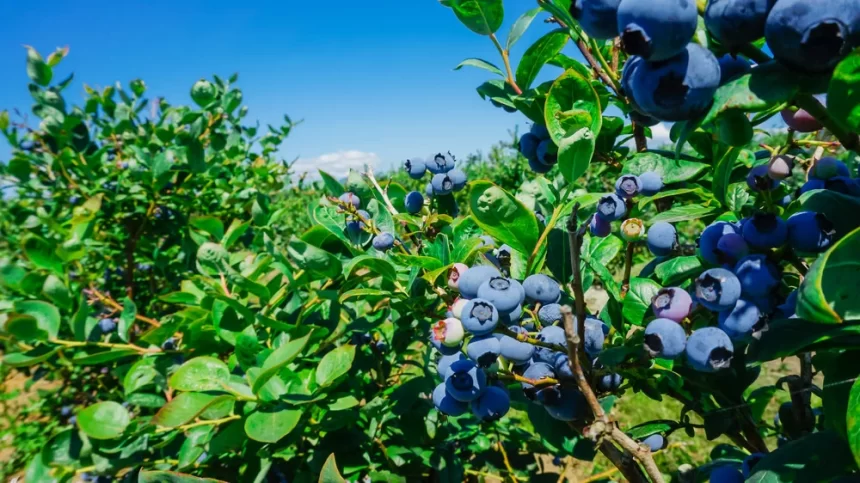Blueberries are a delicious and healthy fruit that can be grown in home gardens with the right conditions. Blueberry plants require acidic soil with a pH between 4.5-5.5 and like lots of organic matter. They also have shallow root systems and need irrigation. By providing the proper soil environment and care, you can harvest pounds of plump, juicy blueberries from your own backyard.
Growing companion plants alongside blueberries can be beneficial in several ways. Certain plants can help improve soil conditions for blueberries, attract pollinators, provide shade or wind protection, or repel pests. Choosing the right blueberry companion plants allows you to maximize your garden space and create symbiotic relationships between plants.
Selecting a Planting Site
When choosing where to plant blueberries, site selection is key. Blueberries require:
| Full Sun | Blueberry plants need at least 6 hours of direct sunlight per day. Morning sun is preferable to help dry foliage after rain or dew. |
| Well-Drained Soil | Blueberries cannot tolerate wet feet. Ensure water drains away from the root zone. Raised beds can improve drainage. |
| Acidic Soil with Organic Matter | Test soil pH and amend with sulfur to reach an acidic level if needed. Mix in compost or peat moss. |
| Shelter from Wind and Temperature Extremes | While allowing for good air circulation, buffer plants from harsh elements. |
Preparing the Soil
Blueberries need acidic soil with lots of organic matter. When preparing a new planting bed:
- Check the Soil pH: The ideal pH range is between 4.5-5.5. Test kits are inexpensive and provide results within minutes.
- Lower the pH if Needed: Mix elemental sulfur into the soil, allowing 6-12 months before planting for full effect.
- Add Compost and Peat Moss: Incorporate generous amounts of organic materials like compost, peat moss, rotted manure.
- Create Raised Beds: Building up planting mounds will improve drainage.
Selecting Blueberry Plants
Choose blueberry varieties suited to your growing zone. Early, mid and late-season cultivars will extend your harvest. Check plant tags for chill hour requirements.
Popular Varieties Include:
- Northland
- Northblue
- Bluecrop
- Elliott
- Jersey
- Duke
Purchase Certified, Virus-Free Plants
Buy 1-2 year old plants from reputable nurseries. Reject plants with discolored stems or leaves.
Planting Blueberries
Follow these tips when placing blueberry plants in prepared garden beds:
- Allow Enough Space: Give mature plants 6 feet between centers, with rows 8-10 feet apart.
- Plant at Correct Depth: Ensure the root ball sits no deeper than 1 inch below soil level.
- Water Thoroughly: Water well upon planting and as needed until established.
Caring for Blueberry Plants
Proper watering, pruning and fertilization keeps plants healthy and productive:
| Water 1-2 Inches per Week | Blueberries are shallow-rooted. Consistent moisture is important. |
| Mulch Around Plants | Aged bark chips or pine needles help retain soil moisture and acidity. |
| Prune for Shape and Productivity | Prune out old stems after harvest. Tip back overgrown tops. |
| Apply Sulfur if Soil pH Rises | Recheck pH yearly and add sulfur if needed to maintain acid levels. |
| Fertilize with Acid Fertilizer | Use acidic fertilizer made for blueberries at bud break and again after harvest. |
Companion Plants for Blueberries
Adding the right companion plants around blueberries enhances the garden in many ways:
- Improve Pollination: Attract bees, butterflies, hummingbirds and other pollinators.
- Repel Pests: Deter aphids, beetles, caterpillars and flies.
- Enhance Soil Conditions: Fix nitrogen, accumulate minerals, improve drainage.
- Provide Support: Sturdy nearby plants offer wind protection.
- Complement Growth Habits: Early and late harvest times extend fruiting seasons.
Here are some of the best choices for blueberry companion plants:
Wild Columbine
The red tubular flowers of wild columbine attract hummingbirds which also pollinate blueberry blooms. Columbine grows well in wooded areas and enjoys the same soil conditions preferred by blueberries. Since it emerges early in spring, columbine flowers provide nectar before blueberry bushes even bloom. It Looks beautiful interplanted with blueberries.
Bee Balm
With its red or pink flower clusters, bee balm lures butterflies and bees to your landscape. The lavender-scented foliage deters common blueberry pests like Japanese beetles, aphids and flies. Being a member of the mint family, bee balm spreads easily so site it carefully. But allow some to wander among your blueberry bushes.
Astilbe
The feathery flower plumes of Astilbe brighten up shady areas where blueberries thrive. Various Astilbe species and cultivars provide interest spring through fall. The wide leaves help shelter blueberry plants from wind and sun. Astilbe improves drainage and air circulation with it’s loose growing habit.
Russian Sage
Russian sage is prized for it’s silvery foliage and beautiful blue flower spikes. It attracts bees while repelling Japanese beetles. Since Russian sage blooms during summer it provides bloom overlap with blueberries. It adapts readily to acid soil yet handles some drought. Give it space to fill in around blueberries.
False Indigo
False indigo is a native flowering shrub that hosts nitrogen-fixing bacteria on it’s roots to enrich the soil. The purple flowers appear just as blueberries finish bloom. It grows several feet tall but does not spread invasively. False indigo is useful as a border or background plant in the blueberry patch.
Yarrow
This perennial herb has pretty, lacey leaves and summer-blooming flower heads that attract ladybugs, parasitic wasps and other beneficial insects that prey on blueberry pests. Being deep-rooted, yarrow does not compete with shallow blueberry roots. And since it repels Japanese beetles that damage blueberry bushes, plant plenty of yarrow throughout the blueberry patch.
Calendula
The bright orange and yellow blossoms of calendula cheer up any garden. Calendula repels aphids, whiteflies and other insects that bother blueberries. It also inhibits weed growth. Scatter calendula seed or tuck in transplants around the base of blueberry bushes and allow some flowers between plants. Calendula blooms constantly if spent blossoms get removed.
Marigolds
Marigolds deter nematodes, aphids and rabbits. They produce chemical compounds that limit weed growth. As a bonus, marigold flowers can be used in salads. For best effect interplant marigold throughout blueberry beds. Choose shorter varieties like ‘Petite Mix’ so tall blueberry plants don’t get lost behind them.
Mint
Spearmint, orange mint, peppermint and other culinary mints enrich soil with nutrients through their vigorous root systems. They repel aphids, mites, flea beetles, flies and mosquitoes when planted near blueberries. Be aware that their spreading nature requires keeping them contained in pots or limited garden areas.
White Clover
White clover makes an excellent living mulch between blueberry plants, fixing nitrogen from the air into the soil. Its shallow roots don’t compete with blueberry roots. And since clover blooms at a low growth height, it won’t obstruct pickers. The low carpet of green leaves cools soil and improves moisture retention.
Oregano
Like other aromatic herbs, oregano can help chase away troublesome insects. Research shows oregano oil provides fungicidal action against common blueberry pathogens. Tuck a few oregano plants around your blueberries or scatter seeds between plants as an attractive ground cover. The blueberry patch will smell great at harvest time!
Nasturtiums
No insects bother nasturtiums due to the mustard oil they contain. Planting them around blueberries creates a protective buffer zone. Caterpillars and beetles will stay away. Butterflies visit the brightly colored nasturtium flowers but do no damage. Use nasturtiums at the garden edge or tuck them between blueberry plants.
Companion Planting Tips:
- Place taller companion plants north of lower-growing blueberry bushes to avoid shading.
- Allow a 2 foot radius weed-free zone around each blueberry plant.
- Group companion plants together in pockets rather than dot them randomly around.
- Scatter beneficial attractant plants throughout the bed to interest pollinators.
- Concentrate pest-deterring plants most heavily around the garden perimeter.
By combining beauty and function, companion plants enhance blueberry plantings in many positive ways. Observe the interactions as your garden matures and keep notes for ongoing improvements. Soon you’ll have a thriving system where plants mutually support each other’s growth.
Caring for Mature Blueberry Bushes
Give blueberry plants attention over time to maintain health and fruit production:
| Water 1-2 Inches Weekly | Blueberries need consistent soil moisture. Spread mulch to conserve water. |
| Prune Out Old Stems | Remove stems over 6 years old to improve productivity. |
| Harvest Fruit Promptly | Pick berries fully blue. Remove any damaged or spoiled fruit promptly. |
| Guard Against Birds | Use bird netting if necessary to allow humans to enjoy the ripe fruit. |
| Scout for Pests | Watch for signs of insects, mites, or disease. Take control measures as needed. |
Harvesting Blueberry Fruit
Within 1-3 years after planting, blueberry bushes will begin bearing fruits. Enjoy summer harvests for 20 years or longer from mature plants.
Blueberry Facts:
- White unripe blueberry fruit turns red, then purple, then blue when fully ripe.
- IDEAL sugar content is around 14% at peak ripeness.
- Each plant yields 5-20 pounds per year depending on age and variety.
- Patience pays because fruit size and sweetness improve in years 2-5 before leveling off.
How to Pick:
Gently roll ripe berries off stems with thumb & forefinger to keep branches intact.
- Harvest in early morning or cool evening.
- Avoid bruising delicate fruit; use shallow containers.
- Move picked berries out of sunlight promptly.
- Refrigerate berries soon as possible after picking.
Storage Tips:
- Store unwashed berries loosely covered in refrigerator 2-3 days maximum.
- Freeze extra fruit on cookie sheets before storing in bags long term.
Enjoy summer’s bounty! Blend berries into smoothies, fold into pancakes, layer into parfaits, sprinkle on salads or savor by the sweet handful. Homegrown blueberries simply can’t be beat!
This in-depth guide covers all key aspects of successfully growing delicious blueberries and compatible companion plants in your backyard garden. Use the tips here to establish thriving bushes, harvest bumper crops of fruit, and keep your plants healthy for years of production.
Common Pests and Diseases
Even a well-cared for blueberry patch can sometimes have issues with insects, animals, or plant diseases. Being aware of potential problems is the first step.
| Japanese Beetles | These shiny green and copper beetles devour leaves and ripe fruit. Hand pick early before populations explode and use row covers to exclude them. |
| Birds | Robins, finches, and other birds love sweet blueberries as much as people. Protect ripening fruit with bird netting when necessary. |
| Aphids | Tiny soft-bodied insects cluster on new growth and suck plant juices. Strong sprays of water can dislodge them. Ladybugs and lacewings will feed on them. |
| Mummy Berry Fungus | This disease first forms tan lesions on expanding leaves. Later fruit mummifies into grey masses. Remove affected fruit and mulch to suppress spores. |
| Blossom Drop | If cold snaps occur during bloom time, the flowers abort and no fruit forms. Cover plants when frost threatens until blossoms pass. |
| Rabbits and Deer | These large animals browse twigs and bark over winter. Use fencing, repellents, or scare devices to protect plantings. |
Be observant and take action promptly when any issues arise before irreparable damage occurs. This ensures a healthy, productive blueberry patch for years to come.
Expanding Your Blueberry Planting
As blueberry bushes mature, open up additional garden space for new plants. Expanding allows you to :
- Add different blueberry varieties
- Extend the harvest season
- Increase total yields
- Improve pollination
Follow the same site preparation, plant selection, and planting steps outlined earlier. Over time you can grow enough blueberries to freeze, gift to friends and incorporate into jams, syrups and baked treats.
Alternative Fruits for the Edible Landscape
While blueberries have special soil needs, many other fruits grow well near them:
- Strawberries: Strawberry plants thrive around blueberry bushes if provided rich soil. The ripening times usually don’t overlap. Grow everbearing types for summer and fall harvests.
- Raspberries and Blackberries: Brambles tolerate more alkaline soil than blueberries but add beauty and delicious contrast to an edible garden. Plant thornless varieties for easier harvests if they won’t get too wild.
- Currants and Gooseberries: These woody shrubs produce edible spring fruits that precede blueberries. They tolerate some shade which allows planting them on the north side. Protect from imported currant worms that skeletonize leaves.
- Fruit Trees: Apples, cherries, pears and plums get planted in their own orchard area. But underplant blueberry bushes nearby to maximize production from the garden real estate.
- Grapes and Kiwi: Grow vigorous vines on sturdy trellises along sunny garden edges. They won’t harm blueberry plants. Just contain them to prevent heavy shade.
Keep in mind pollination timing when siting plants near each other. Planning ahead promises a long harvest spanning multiple seasons. Soon you’ll enjoy homegrown fruits from spring through fall.
Natural Pest and Disease Remedies
If pests or diseases show up, try these organic treatment options first before turning to harsher chemical controls:
- Insecticidal soap spray – Mix 2 Tbsp insecticidal soap with 1 gallon water. Spray on infested plants weekly until insects gone. Safe for people and pets when dry.
- Neem oil – This organic oil deter pests and contains antifungal properties. Follow label rates. Reapply after rain.
- Diatomaceous earth – Spread this powder made of crushed sea fossils on soil. It abrades soft-bodied insects. Nontoxic to mammals.
- Pyrethrum spray – Made from chrysanthemum extracts, pyrethrum quickly knocks down insects but leaves no residual action. Don’t apply to blooms bees are actively working.
- Bacillus thuringiensis (Bt) – This natural bacteria kills leaf-eating caterpillars when they ingest it but spares other insects. Must be reapplied after rain.
- Sulfur/lime sulfur – Controls fungal issues on contact by preventing spore production. Use caution as it may burn plants if over-applied during hot weather. Never mix with oils.
- Compost tea – Steep quality compost in water for days then strain and spray. Boosts plants’ immune defenses against diseases.
- Row covers – Cover plants with fabric at start of season to exclude insect pests. Remove during bloom so bees can pollinate.
Focus first on cultural fixes like improving soil and plant health before issues spiral out of control. But have organic remedies ready to judiciously apply for more stubborn problems when needed. This balanced IPM (integrated pest management) approach helps nurture a naturally healthy, productive garden.
Enjoying the Fruits of Your Labor
After investing time establishing and tending your blueberry patch, make sure to enjoy the literal fruits of your labor once they start ripening! Berries fresh off the bush burst with sweet tangy flavor that store-bought fruits can’t match.
Eating Blueberries:
- Garnish yogurt, oatmeal and other breakfast foods
- Blend into smoothies, juices or lemonade
- Mix with other fruits in parfaits or fruit salads
- Fold into muffins, pancakes, coffee cakes
- Stir into ice cream for dessert treats
- Sprinkle on green salads for delicious contrast
- Accompany meats like duck, chicken or pork
- Toss with greens and feta or goat cheese
- Freeze excess for year-round enjoyment
Over time, get creative using blueberries in new ways. Preserve abundant harvests as jams, jellies, syrups or dehydrated fruit leathers. Package homemade blueberry products attractively for holiday gift-giving.
Most importantly, cultivate appreciation for the native fruits produced organically right in your own backyard. There’s nothing more satisfying than harvesting and eating just-picked blueberries still warm from the summer sun!
Conclution
From proper plant selection to harvest time excitement, blueberries are a rewarding fruit to cultivate in home gardens. Given acidic, organic-rich soil and adequate irrigation, blueberry plants will reward you with abundant clusters of sweet, nutritious berries.
Interplanting blueberry bushes with attractive companion plants that deter pests, enhance pollination, or improve soil conditions creates a high-functioning edible landscape. Once mature, a well-designed blueberry patch essentially takes care of itself while producing fruit year after year.
Make this the year you plant blueberries if suitable space allows. Follow the helpful growing guidelines outlined above for establishing new bushes or improving existing ones. With reasonable care, your plants will bear delicious fruit for decades as a legacy for your family and community.
FAQs
With proper care, a healthy blueberry plant can remain productive for 20-25 years. Prune out old stems regularly to encourage new fruiting wood.
Use an acidic fertilizer formulated specially for blueberries. Apply per label directions in early spring and again after harvest. Avoid high nitrogen formulas.
Prune in late winter or very early spring before buds swell and break dormancy. Avoid pruning immediately after harvest when plants are stressed.
Space mature blueberry plants at least 6 feet apart in rows 8-10 feet apart to allow air circulation and access between plants for care, pollination and harvesting.
Yes, pinch off any flowers the first spring to redirect the plant’s energy into root and canopy establishment rather than fruit production.
This harmless epicuticular wax coating on leaves helps retain moisture. Don’t confuse it with the pathogenic white fungal growth of powdery mildew disease.
Use an inexpensive soil test kit. Or monitor with hydrangeas since they require the same pH range as blueberries to produce blue flowers.
Yes, pine straw makes excellent mulch to retain soil moisture and acidity preferred by blueberries. Spread several inches deep around plants, leaving space near trunks.




What’s Taking place i’m new to this, I stumbled upon this I’ve
found It absolutely useful and it has helped me out loads.
I am hoping to contribute & assist other customers like its aided
me. Good job.